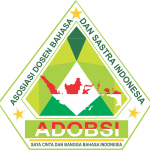KERAJINAN ROTAN SEBAGAI WARISAN BUDAYA DAYAK LUNDAYEH DALAM PERSPEKTIF KEARIFAN LOKAL
Abstract
This study aims to describe the rattan craft as a cultural heritage of the Dayak Lundayeh in the perspective of local wisdom in the Pulau Sapi tourist village, mentarang sub-district, malinau district. The sources in this study are rattan handicraft makers, rattan collectors who produce rattan crafts in the Pulau Sapi tourist village, Mentarang sub-district, Malinau district. Type of qualitative descriptive research. Data collection method by conducting literature review, observation, in depth interviews and documentation. Based on the results of the research as follows: 1) how to choose a good rattan to use in making rattan crafts. First: clean around the rattan to be taken. Second: the types of rattan that can be taken are leaves that have peeled off from the rattan stem which are brown in color and the texture of the rattan is not too old and easy so it is good to. 2) the value of local wisdom contained in rattan crafts is the value in the manufacturing process. First: patience in weaving rattan crafts, so that it can be applied in everyday life to be patient to get good results. Second: accuracy, get maximum results to have good quality. Third: perseverance, good use of time in doing something in a short time. Fourth: neatness, to get good results and become an attraction to the model and a neat arrangement. Fifth: beauty, in addition to neatness, the important thing to note is also about beauty as an added value in appearance. Sixth: don’t give up easily, in making something everything doesn’t always go well there must be mistakes, so in making rattan crafts you must have an unyielding spirit and want to try.
Keywords
Full Text:
PDFReferences
Anto, R. (2019). Narasi Profil Desa Pulau Sapi. https://scribd.com/document/423761563/Narasi-Profil-Desa-Pulau-sapi
Brata, I. B. (2016). Kearifan budaya lokal perekat identitas bangsa. Jurnal Bakti Saraswati, 5(1).
Depodikbud. (n.d.). Data Sekolah. https://sekolah.data.kemdikbud.go.id/index.php/chome/profil/102a397e-30f5-e011-b86b-a707d9c1951d.
Huberman, A. M., & Miles, M. B. (2009). Manajemen data dan metode analisis. In N. K. Denzin & Y. S. Lincoln (Ed.), Handbook Of Qualitative Research. Pustaka Pelajar.
Kalima, T., & Jasni, J. (2010). Tingkat kelimpahan populasi spesies rotan di hutan lindung batu kapar, gorontalo utara. Jurnal Penelitian Hutan dan Konservasi Alam, 7(4), 439–450. https://doi.org/10.20886/jphka.2010.7.4.439-450
Kuntjara, E. (2006). Penelitian Kebudayaan Sebuah Panduan Praktis Edisi 2. Graha Ilmu.
Surya, A., & Mutmaniah, S. (2016). Kerajinan anyam sebagai pelestarian kearifan lokal. Jurnal Dimensi Seni Rupa dan Desain, 12(1), 1–10. https://doi.org/10.25105/dim.v12i1.65
Usman, H., & Akbar, P. S. (2017). Metodologi penelitian sosial. Bumi Aksara.
Refbacks
- There are currently no refbacks.






